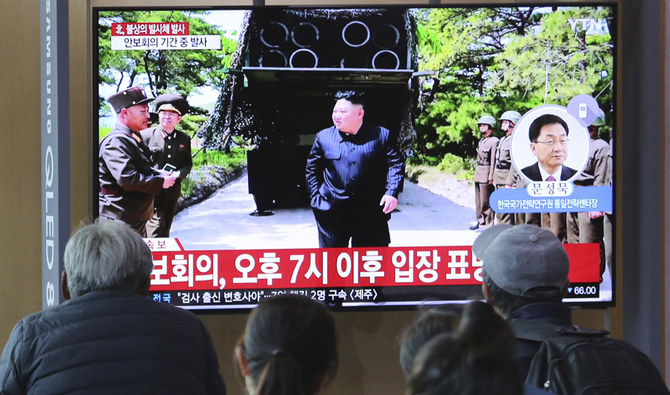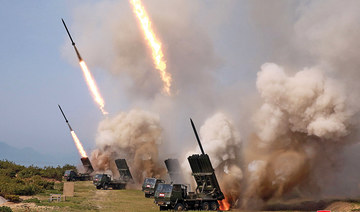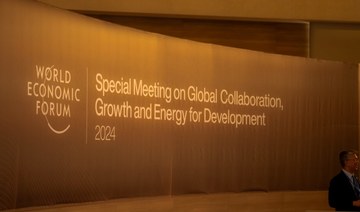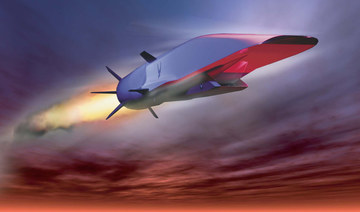SEOUL: North Korea reportedly launched two short-range missiles on Thursday afternoon — its second military provocation in five days following the testing of several rockets and missiles last Saturday.
The North’s latest test firing coincided with the visit to Seoul of the US’s top nuclear envoy Stephen Biegun, and comes at a time when South Korean President Moon Jae-in is attempting to persuade politicians that South Korea should provide food aid to the North, which is currently facing a potentially disastrous shortage following its worst harvest in 10 years.
According to the Joint Chiefs of Staff, the missiles were fired from the north-eastern city of Kusong toward the eastern waters between 4:29 p.m. and 4:39 p.m. One of the missiles flew 420 km, and the other 270 km.
In 2017, the North launched a long-range ballistic missile, Hwasong-12, and a ground-to-ground missile, nicknamed Pukguksong-2, in the Kusong area.
“We have strengthened surveillance and vigilance in case of an additional missile launch by the North,” the JCS said in a statement. “Both South and US militaries are analyzing the details of the projectile.”
President Moon expressed his concern over the launch of the missiles, which he said could violate UN resolutions that ban the North from firing any kind of ballistic missile.
“If they are ballistic missiles, even if they are short-range, (they) could be in violation of UN resolutions,” Moon said during an interview with a local broadcasting station on the occasion of the second anniversary of his inauguration.
Still, the president — who favors negotiation with the North — was trying to leave room for diplomacy.
“UN resolutions, in fact, target the North’s intercontinental ballistic missiles, and the international community has never taken issue with short-range missiles,” he said.
“Nevertheless, I warn that such actions, if repeated, will make it more difficult to maintain dialogue and negotiations down the road.”
This week’s missile launches were expected to top the agenda when Biegun met with South Korean officials on Friday.
Having arrived late on Wednesday, Biegun was scheduled to make a courtesy call on President Moon on Friday morning and meet with key security-related officials, including Chung Eui-yong, director of the presidential national security office, and Foreign Minister Kang Kyung-hwa, to discuss the missile launches and the potential provision of food aid to the North.
On Tuesday, Moon spoke with US President Donald Trump to discuss his plan to provide food to North Korea, and Trump reportedly expressed his support.
“We’ll push for sending food to North Korean citizens in cooperation with the international community,” said Lee Sang-min, spokesman for the Ministry of Unification on North Korean affairs. “Discussions are underway among related government offices to lay out details of food assistance.”
According to the UN, an estimated 10.1 million people — or 40 percent of the North Korean population — are in urgent need of assistance after this year’s harvest.
The regime cut daily rations to less than 11 ounces per person in January, compared to over 13 ounces per person in January 2018, according to the World Food Program, and the UN’s Food and Agriculture Organization.
Food shortages in North Korea have been aggravated by the international sanctions imposed in 2016, which have choked the regime’s cash flow, making it difficult for the state to import food.
While America remains cautious about providing the North with materials, fearing that the regime would use any aid for military purposes, Washington has confirmed that it will not stand in South Korea’s way if Seoul chooses to provide food aid to the North.
“Our position in regards to North Korea is going to continue to be the maximum pressure campaign,” White House press secretary Sarah Sanders told reporters on Wednesday.
“Our focus is on the denuclearization. (But) if South Korea moves forward on that front, we’re not going to intervene.”
US Secretary of State Mike Pompeo stressed that the international community should maintain pressure on North Korea until it gives up its nuclear weapons program completely.
“President Trump has led tough diplomacy toward the final, fully verified denuclearization of North Korea,” Pompeo said in a speech in London on Wednesday. “That mission is important, and the pressure campaign that the world has engaged in must continue.”
Local experts believe food aid may not be an effective way of luring the North to the negotiating table, although the South hopes that such assistance could set the stage for the fourth round of talks between Moon and North Korean leader Kim Jong-un.
“The latest provocation sends a clear message that they will not come to the negotiating table unless the United States changes its attitude toward denuclearization talks,” said Kim Dong-yub, a professor at Kyungnam University’s Institute for Far Eastern Studies in Seoul. “The North is not likely to be induced just by food aid.”
And in Seoul, politicians are divided over whether to provide food to the North or not.
“For the sake of peace and maintaining the momentum of dialogue with North Korea, humanitarian assistance should be implemented as soon as possible,” Rep. Lee Hae-shik of the governing Democratic Party said on Thursday.
But Rep. Min Kyung-wook, spokesman for the main opposition Liberty Korea Party, rebutted Lee’s claim, saying: “We’re not opposed to any humanitarian assistance to the North Korean people, but this is not the time. If the South provides food aid now, the North will think their provocation bore fruit.”
Analysts believe the North has been developing new short-range missiles modeled after Russia’s Iskander system. Developed in the 1970s, the Iskander is a road-based mobile launch system that can fire multiple ballistic and cruise missiles. It is known to have a range of up to 500 kilometers.
“The missile is potentially capable of conducting strikes on all areas of South Korea, including key American military installations,” said the Kyungnam University professor. “(The most troubling thing) is that the missile could carry a nuclear warhead of up to 500 kilos.”
Retired three-star general Shin Won-shik warned that the Russian-type short-range missile could be capable of evading missile defense systems.
“The South Korean missile shield was developed to cope with existing ballistic missiles, (including) Scud and No Dong. So there are questions about whether the current missile defense plans are (equipped to deal with) the threat of newer missiles,” said Shin.
South Korea is working on a low-tier missile shield — the Korea Air and Missile Defense system or KAMD — a network that includes Patriot Advanced Capability-2 and -3 interceptors, ship-based SM-2 missiles, and locally developed medium-range surface-to-air missiles. The US Army’s Terminal High Altitude Area Defense system was deployed in the southern part of South Korea in 2007 to augment the low-tier, terminal-phase KAMD.






























